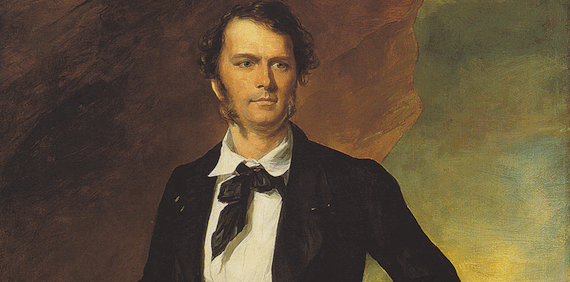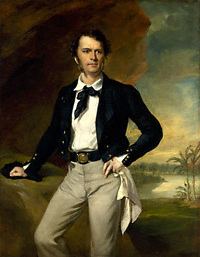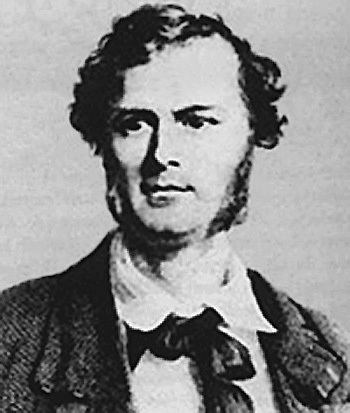Coronation 18 August 1842 Name James Brooke Education Norwich School House Brooke dynasty Parents Thomas Brooke | Spouse none Role White Rajahs | |
 | ||
Reign 18 August 1842 – 11 June 1868 Predecessor Sultan Tengah (as Sultan of Sarawak), Pengiran Indera Mahkota Mohammad Salleh (as Governor of Sarawak) Born 29 April 1803Bandel, Hooghly, British India ( 1803-04-29 ) Books The Private Letters of Sir James Brooke, Rajah of Sarawak V1: Narrating the Events of His Life from 1838 to the Present Time Cousins Thomas Wyatt the Younger Similar People Charles Brooke - Rajah of, Charles Vyner Brooke, Maha Bandula, Joseph Wanton Morrison, Thomas Wyatt the Younger | ||
Favourite story about james brooke
Sir James Brooke, Rajah of Sarawak, KCB (29 April 1803 – 11 June 1868), was a Briton born and raised under the Company Raj in NE India, who became the first White Rajah of Sarawak in Borneo.
Contents
- Favourite story about james brooke
- James brooke
- Early life
- Sarawak
- Cession of Labuan to Great Britain
- Accession as Rajah of Sarawak
- Reign
- Death and burial
- Successor
- Personal life
- Fiction
- Honours and legacy
- References

After a few years of education in England, he served in the Bengal Army, was wounded, and resigned his commission. He bought a ship and sailed out to the Malay Archipelago where, by helping to crush a rebellion, he became governor of Sarawak. He then vigorously suppressed piracy in the region and, in the ensuing turmoil, restored the Sultan of Brunei to his throne, for which the Sultan made Brooke the Rajah of Sarawak. He ruled until his death.

Brooke was not without detractors and was criticised in the British Parliament and officially investigated in Singapore for his anti-piracy measures. He was, however, honoured in London for his work. The naturalist Alfred Russel Wallace was one of many visitors whose published work spoke of his hospitality and achievements. His final years were spent quietly in England.

James brooke
Early life
Brooke was born in Bandel, near Calcutta, Bengal, but baptised in Secrole, a suburb of Benares. His father, Thomas Brooke, was an English Judge in the Court of Appeal at Bareilly, British India; his mother, Anna Maria, born in Hertfordshire, was the daughter of Scottish peer Colonel William Stuart, 9th Lord Blantyre, and his mistress Harriott Teasdale. Brooke stayed at home in India until he was sent, aged 12, to England for a brief education at Norwich School from which he ran away. Some home tutoring followed in Bath before he returned to India in 1819 as an ensign in the Bengal Army of the British East India Company. He saw action in Assam during the First Anglo-Burmese War until seriously wounded in 1825, and was sent to England for recovery. In 1830, he arrived back in Madras but was too late to rejoin his unit, and resigned his commission. He remained on the ship he had travelled out in, the Castle Huntley, and returned home via China.
Sarawak
Brooke attempted to trade in the Far East, but was not successful. In 1833 he inherited £30,000, which he used as capital to purchase a 142-ton schooner, Royalist. Setting sail for Borneo in 1838, he arrived in Kuching in August to find the settlement facing an uprising against the Sultan of Brunei. Greatly impressed with the Malay Archipelago, in Sarawak he met the sultan's uncle, Pangeran Muda Hashim, to whom he gave assistance in crushing the rebellion, thereby winning the gratitude of the Sultan, who in 1841 offered Brooke the governorship of Sarawak in return for his help.
Rajah Brooke was highly successful in suppressing the widespread piracy of the region. However, some Malay nobles in Brunei, unhappy over Brooke's measures against piracy, arranged for the murder of Muda Hashim and his followers. Brooke, with assistance from a unit of Britain's China Squadron, took over Brunei and restored its sultan to the throne.
Cession of Labuan to Great Britain
In 1846 Brooke presented the island of Labuan to the British government. He was appointed governor and commander-in-chief of Labuan.
Accession as Rajah of Sarawak
In 1842 Sultan Omar Ali Saifuddien II ceded complete sovereignty of Sarawak to Brooke. He was granted the title of Rajah of Sarawak on 24 September 1841, although the official declaration was not made until 18 August 1842.
Reign
During his reign, Brooke began to establish and cement his rule over Sarawak: reforming the administration, codifying laws and fighting piracy, which proved to be an ongoing issue throughout his rule. Brooke returned temporarily to England in 1847, where he was given the Freedom of the City of London, appointed British consul-general in Borneo and created a Knight Commander of the Order of the Bath (KCB).
Brooke became the centre of controversy in 1851 when accusations against him of excessive use of force against natives, under the guise of anti-piracy operations, ultimately led to the appointment of a Commission of Inquiry in Singapore in 1854. After investigation, the Commission dismissed the charges but the accusations continued to haunt him.
Brooke wrote to Alfred Russel Wallace on leaving England in April 1853, "to assure Wallace that he would be very glad to see him at Sarawak." This was an invitation that helped Wallace decide on the Malay Archipelago for his next expedition, an expedition that lasted for eight years and established him as one of the foremost Victorian intellectuals and naturalists of the time. When Wallace arrived in Singapore in September 1854, he found Rajah Brooke "reluctantly preparing to give evidence to the special commission set up to investigate his controversial anti-piracy activities."
During his rule, Brooke faced threats from Sarawak warriors like Sharif Masahor and Rentap, and an uprising by Liu Shan Bang in 1857, but remained in power.
Death and burial
Brooke ruled Sarawak until his death in 1868, following three strokes over ten years.
All three White Rajahs are buried in St Leonard's Church in the village of Sheepstor on Dartmoor.
Successor
Having no legitimate children, in 1861 he formally named Captain John Brooke Johnson-Brooke, his sister's eldest son, as his successor. Two years later, the Rajah reacted to criticism by returning to the east: after a brief meeting in Singapore John was deposed and banished from Sarawak. James increased the charges to treasonous conduct and later named John's younger brother, Charles Anthoni Johnson Brooke, as successor.
Personal life
Brooke was influenced by the success of previous British adventurers and the exploits of the British East India Company. His actions in Sarawak were directed at expanding the British Empire and the benefits of its rule, assisting the local people by fighting piracy and slavery, and securing his own personal wealth to further these activities. His own abilities, and those of his successors, provided Sarawak with excellent leadership and wealth generation during difficult times, and resulted in both fame and notoriety in some circles. His appointment as Rajah by the Sultan, and his subsequent knighthood, are evidence that his efforts were widely applauded in both Sarawak and British society.
Among his alleged relationships was one with Badruddin, a Sarawak prince, of whom he wrote, "my love for him was deeper than anyone I knew." This phrase led to some considering him to be either homosexual or bisexual. Later, in 1848, Brooke is alleged to have formed a relationship with 16‑year‑old Charles T. C. Grant, grandson of the seventh Earl of Elgin, who supposedly 'reciprocated'. Whether this relationship was purely a friendship or otherwise has not been fully revealed. One of Brooke's recent biographers wrote that during Brooke's final years in Burrator in Devon "there is little doubt ... he was carnally involved with the rough trade of Totnes." However, Barley does not note from where he garnered this opinion. Others have suggested Brooke was instead "homo-social" and simply preferred the social company of other men, disagreeing with assertions he was a homosexual.
Although he died unmarried, he did acknowledge one son. Neither the identity of the son's mother nor his birth date is clear. This son was brought up as Reuben G. Walker in the Brighton household of Frances Walker (1841 and 1851 census, apparently born ca. 1836). By 1858 he was aware of his Brooke connection and by 1871 he is on the census at the parish of Plumtree, Nottinghamshire as "George Brooke", age "40", birthplace "Sarawak, Borneo". He was married (in 1862) and had seven children, three of whom survived infancy; the oldest was called James. George died travelling to Australia, in the wreck of the SS British Admiral on 23 May 1874. A memorial to this effect – giving a birthdate of 1834 – is in the churchyard at Plumtree.
James Brooke was 'a great admirer' of the novels of Jane Austen, and would 'read them and re-read them', including aloud to his companions in Sarawak.
Fiction
Fictionalised accounts of Brooke's exploits in Sarawak include Kalimantaan by C. S. Godshalk and The White Rajah by Nicholas Monsarrat. Another book, also called The White Rajah, by Tom Williams, was published by JMS Books in 2010. Brooke is also featured in Flashman's Lady, the 6th book in George MacDonald Fraser's meticulously researched The Flashman Papers novels; and in Sandokan: The Pirates of Malaysia (I pirati della Malesia), the second novel in Emilio Salgari's Sandokan series.
Brooke was also a model for the hero of Joseph Conrad's novel Lord Jim, and he is briefly mentioned in Kipling's short story "The Man Who Would Be King".
Charles Kingsley dedicated the novel Westward Ho! (1855) to Brooke.
Errol Flynn intended to star in a film of Brooke's life called The White Rajah for Warner Bros., based on a script by Flynn himself. However although the project was announced for filming it was never made.
Honours and legacy
British Honours
Some Bornean species were named in Brooke's honour:
In 1857, the native village of Newash in Grey County, Ontario, Canada, was renamed Brooke and the adjacent township was named Sarawak by William Coutts Keppel (known as Viscount Bury, later the 7th Earl of Albemarle) who was Superintendent of Indian Affairs in Canada. James Brooke was a close friend of Viscount Bury's uncle, Henry Keppel; they had met in 1843 while fighting pirates off the coast of Borneo. Townships to the northwest of Sarawak were named Keppel and Albemarle. In 2001, Sarawak and Keppel became part of the township of Georgian Bluffs; Albemarle joined the town of South Bruce Peninsula in 1999. Keppel-Sarawak School is located in Owen Sound, Ontario.
Brooke's Point, a major municipality on the island of Palawan, Philippines, is named after him. Both Brooke's Lighthouse and Brooke's Port, historical landmarks in Brooke’s Point, are believed to have been constructed by Sir James Brooke. Today, owing to erosion and the constant movement of the tides, only a few stones can still be seen at the Port. The remnants of the original lighthouse tower are still visible, although the area is now occupied by a new lighthouse.
